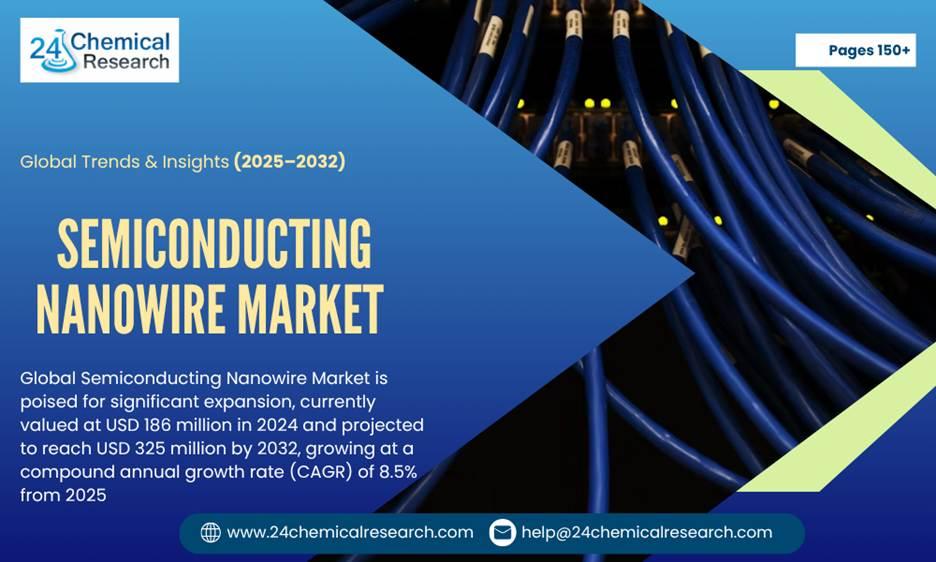Global Semiconducting Nanowire Market is poised for significant expansion, currently valued at USD 186 million in 2024 and projected to reach USD 325 million by 2032, growing at a compound annual growth rate (CAGR) of 8.5% from 2025. This growth trajectory reflects the increasing integration of nanowires in next-generation electronics, renewable energy solutions, and medical technologies. The quantum confinement effects unique to these nanostructures enable breakthroughs in device performance that traditional semiconductors cannot match.
Semiconducting nanowires, with diameters ranging from 1-100 nanometers, demonstrate remarkable electrical and optical properties that are transforming multiple industries. Their adoption in photovoltaic applications shows particular promise, with recent prototypes achieving over 15% energy conversion efficiency while using only 10-20% of the material required by conventional solar cells. This efficiency-to-material ratio creates compelling economic arguments for manufacturers transitioning to nanowire-based solutions.
Download FREE Sample Report: https://www.24chemicalresearch.com/download-sample/297227/global-semiconducting-nanowire-forecast-market-2025-2031-633
Market Segmentation Analysis:
Market Segmentation by Type
- Silicon Nanowires
- InP Nanowires
- GaN Nanowires
- Other Material Types
Market Segmentation by Application
- Electronics & Optoelectronics
- Photovoltaic Devices
- Medical Diagnostics & Sensors
- Energy Storage Solutions
- Other Applications
Market Segmentation and Key Players
- ACS Material
- Novarials Corporation
- Nanostructured & Amorphous Materials
- US Nano
- PlasmaChem GmbH
- CVD Equipment Corporation
- Nano Labs Inc.
- Intelligent Materials Pvt. Ltd.
- NanoComposix
.Future Innovations and Strategic Outlook
The semiconducting nanowire market stands at the forefront of a technological revolution, with innovations rapidly expanding their functional scope and commercial viability. Advances in bottom-up synthesis techniques, such as molecular beam epitaxy and template-assisted growth, are improving nanowire uniformity and structural integrity—key for integration into high-density electronic and optoelectronic devices. Researchers are also developing heterostructured nanowires combining multiple materials at the atomic level to achieve tunable electrical and optical properties, critical for emerging applications like spintronics and neuromorphic computing.
On the commercial front, strategic partnerships between nanowire startups and semiconductor giants are accelerating the transition from lab-scale prototypes to scalable manufacturing. Additionally, government initiatives in the U.S., EU, and Asia are injecting funding into nanotechnology R&D hubs, fostering cross-sector collaborations in areas like flexible electronics, photonic sensors, and bio-nanointerfaces. The integration of AI and machine learning into materials discovery is further expected to optimize nanowire compositions and performance metrics for specific use-cases.
Looking ahead, the successful commercialization of semiconducting nanowires hinges on continued cost reductions, improved CMOS compatibility, and resolution of IP fragmentation. However, with sustained R&D momentum, regulatory support, and expanding end-use sectors—from quantum computing to smart healthcare—the market is well-positioned to become a cornerstone of the next generation of electronics and energy solutions.
Global Market Insights and Regional Dynamics
North America currently dominates the semiconducting nanowire market, accounting for over 40% of global revenue, driven by substantial R&D investments and the presence of leading nanotechnology firms. The region benefits from strong government support, including the U.S. CHIPS Act's $52 billion semiconductor manufacturing incentiv
es, which indirectly boost nanowire adoption. Silicon nanowires represent the largest product segment here, favored for their compatibility with existing semiconductor fabrication processes.
Asia-Pacific emerges as the fastest-growing region, propelled by China's aggressive nanotechnology development under its 14th Five-Year Plan and Japan's leadership in GaN nanowire applications. Europe maintains a strong position in photovoltaic and optoelectronic applications, supported by Horizon Europe's substantial research funding. Emerging markets in Latin America and the Middle East show growing interest, particularly in nanowire-based environmental sensors and renewable energy solutions
Key Factors Propelling Market Growth and Future Prospects
The market's expansion is primarily fueled by three transformative trends: First, the relentless push toward device miniaturization in consumer electronics and IoT applications. Second, the global transition to 5G networks requiring high-frequency components that nanowires uniquely provide. Third, the urgent demand for more efficient photovoltaic technologies as renewable energy adoption accelerates worldwide.
Significant opportunities exist in quantum computing, where nanowires enable the creation of stable qubits with coherence times exceeding 100 microseconds. The medical diagnostics sector presents another high-growth avenue, with nanowire biosensors detecting biomarkers at femtomolar concentrations – enabling earlier disease detection than conventional technologies. Flexible electronics represent a third major opportunity, with foldable displays and wearable devices benefiting from nanowires' mechanical flexibility and superior carrier mobility.
Challenges Affecting Market Expansio
Despite its potential, the nanowire industry faces several barriers to widespread adoption. Production costs remain prohibitively high for many applications, with vapor-liquid-solid (VLS) growth techniques costing 4-5 times more than conventional semiconductor manufacturing. Yield rates in nanowire production still lag behind traditional methods by 10-30%, creating economic hurdles for price-sensitive markets.
Technical challenges around integration with existing CMOS platforms present another significant restraint. The nanoscale precision required for nanowire alignment, coupled with thermal expansion mismatches and doping uniformity issues, limits current implementations to relatively simple device architectures. Intellectual property complexities, with thousands of overlapping patents covering various nanowire technologies, create additional barriers to market entry and innovation.
Report Scope
This comprehensive report provides in-depth analysis of the global semiconducting nanowire market from 2024 through 2032, featuring:
- Market size estimations and growth projections with detailed CAGR analysis
- Technology trend analysis covering material innovations and manufacturing process improvements
- Competitive intelligence on key players' strategies, partnerships, and product portfolios
- Regional market breakdowns highlighting growth opportunities and challenges across geographic markets
- Patent landscape assessment identifying innovation hotspots and potential IP conflicts
- Supply chain analysis mapping raw material sources to end-use applications
The research methodology combines primary interviews with industry experts, analysis of financial reports from publicly traded nanowire companies, and evaluation of patent filings and scientific publications. Our team conducted extensive factory visits and technology assessments to validate production capacities and process efficiencies across the value chain.
Get Full Report Here: https://www.24chemicalresearch.com/reports/297227/global-semiconducting-nanowire-forecast-market-2025-2031-633
Access more Related report-
Contact Us:
Email: help@24chemicalresearch.com
International: +1(332) 2424 294 | Asia: +91 9169162030



